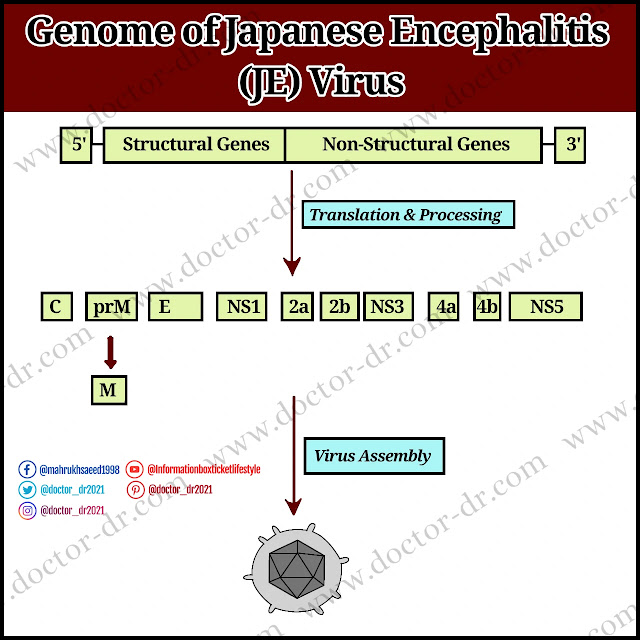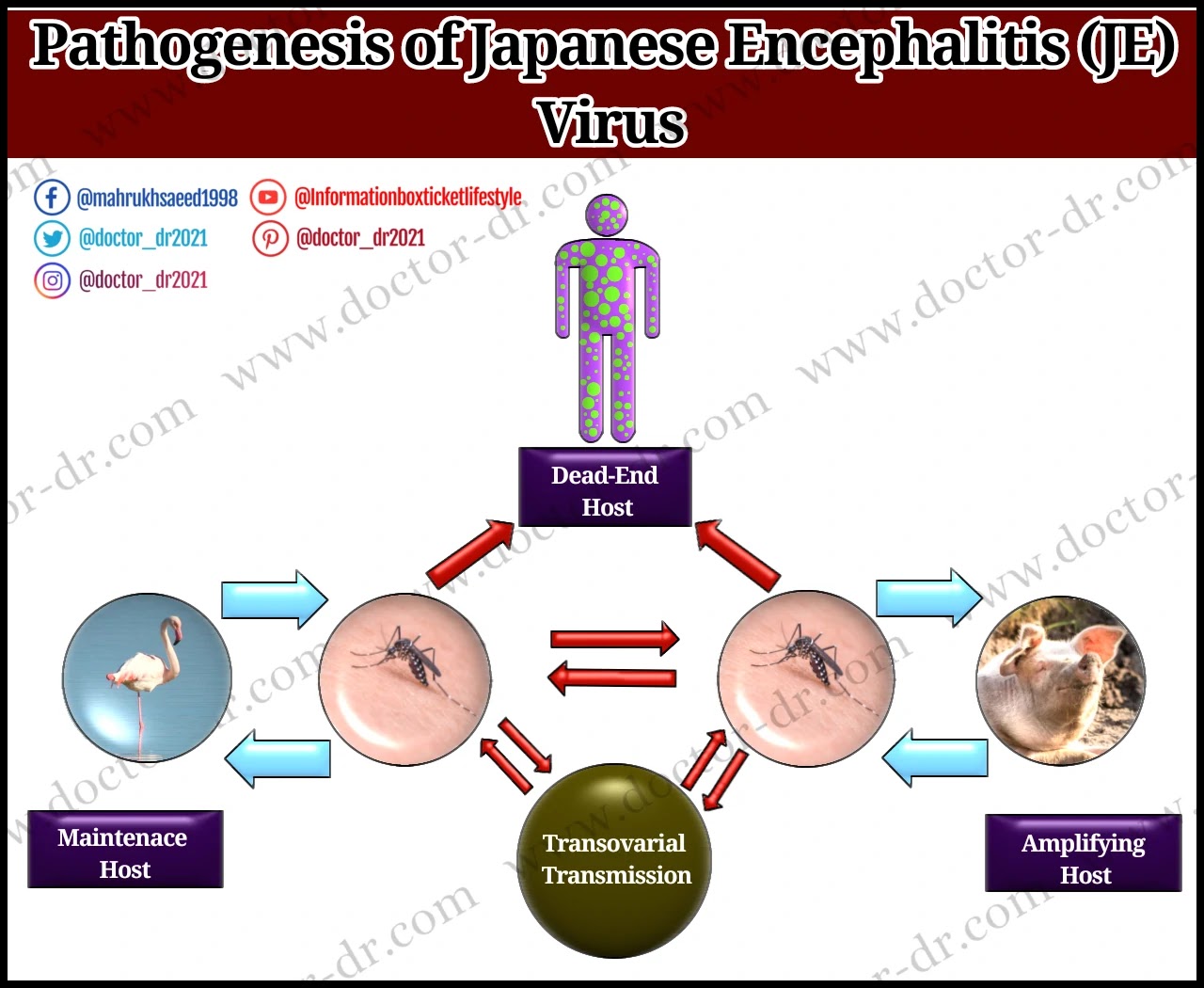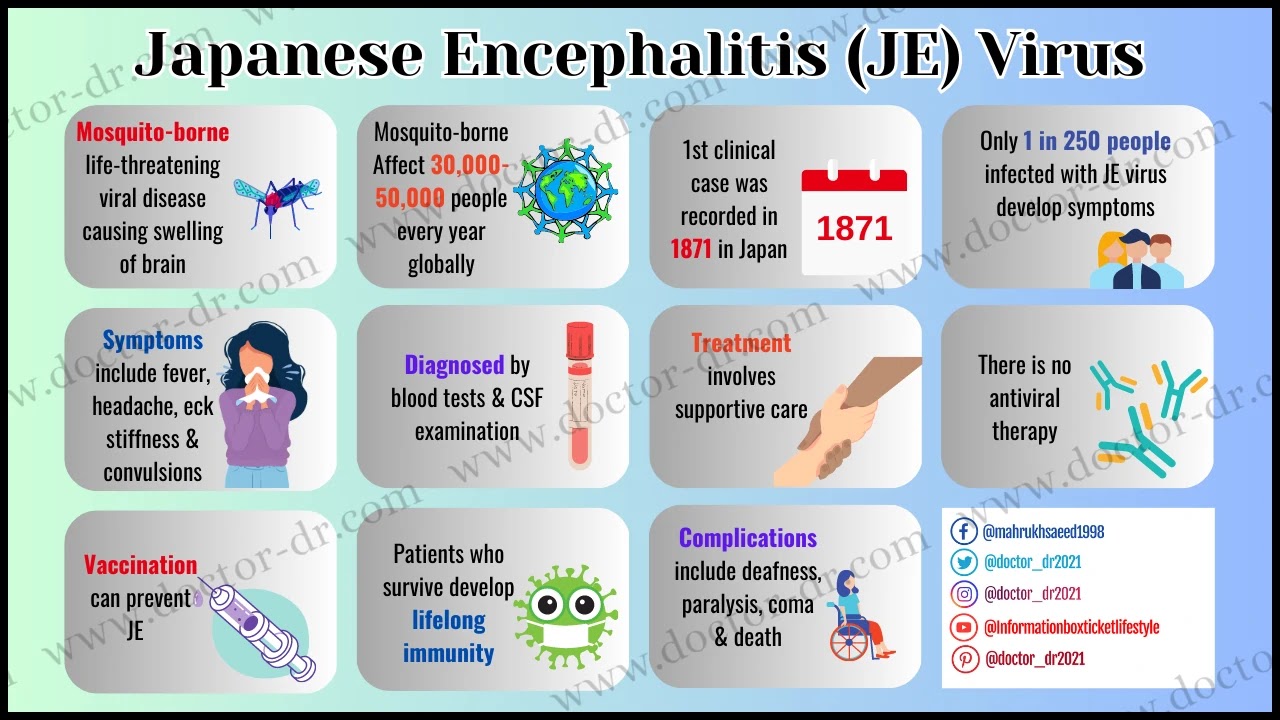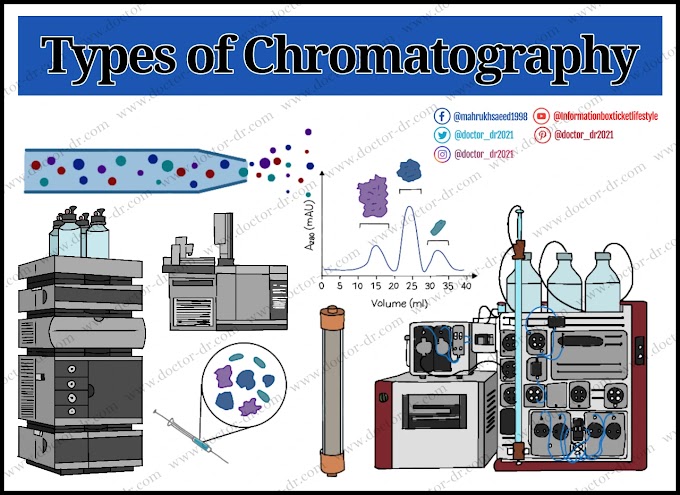Table of Contents
- Structure of Japanese Encephalitis (JE) Virus
- Genome of Japanese Encephalitis (JE) Virus
- Epidemiology and Transmission of Japanese Encephalitis (JE) Virus
- Replication of Japanese Encephalitis (JE) Virus
- Pathogenesis of Japanese Encephalitis (JE) Virus
- Clinical Manifestations of Japanese Encephalitis (JE) Virus
- Laboratory Diagnosis of Japanese Encephalitis (JE) Virus
- Treatment of Japanese Encephalitis (JE) Virus
- Prevention and Control of Japanese Encephalitis (JE) Virus
Structure of Japanese Encephalitis (JE) Virus
- The particles have a core that is 30 nm in diameter and 50 nm in diameter, and they are enveloped by a lipid bilayer.
- The floating density of mature virions sediment between 170 and 210S is 1.19 to 1.23 g/mL.
- It contains the core protein in a nucleocapsid that is surrounded by a tiny lipoprotein envelope.
- The 11 kb long, positively polarised single-stranded RNA genome is likewise contained within the nucleocapsid.
Genome of Japanese Encephalitis (JE) Virus
- The genome is a monopartite, positively polarised, linear single-stranded RNA genome.
- The length of the ssRNA genome is 11 kb.
- This RNA lacks a polyadenylate tail and has a 5′ cap (m7G5'ppp5'A) at the 5′ end.
- The messenger RNA for translating a single lengthy open reading frame (ORF) into a substantial polyprotein is genomic RNA.
- The ORF is surrounded by 5′ and 3′ noncoding regions (NCRs), which are respectively 400–700 nucleotides (nt) and 100–200 nt long.
- The genome is translated as a substantial polyprotein, which is then broken down into at least ten distinct products by cellular proteases and a serine protease that is encoded by a virus.
- The structural proteins are encoded by the polyprotein's N-terminal one-fourth, while the nonstructural (NS) proteins are found in the remaining material, in the following order: C-prM-E-NS1-NS2A-NS3-NS4A-NS4B-NS5.
- The E (envelope), M (membrane), and C (capsid) proteins of the virus are three viral proteins that are connected to virions.
- The primary surface protein of the viral particle, the E protein (50 kD), likely interacts with viral receptors and facilitates fusion of the virus-cell membrane.
- The maturation of the virus into an infectious form depends on the M protein, a 26 kDa tiny proteolytic fragment of prM protein.
- According to its postulated function in creating a ribonucleoprotein complex with packaged genomic RNA, the C protein (approximately 11 kD) is extremely basic.
Epidemiology and Transmission of Japanese Encephalitis (JE) Virus
- The JE virus spreads spontaneously between wild and domestic birds as well as pigs and is contracted by the bite of a Culex mosquito.
- The virus is kept alive by mosquitoes and amplifying vertebrate hosts, primarily pigs, in an enzootic cycle.
- The most significant one is Culex tritaeniorrhynchus, which breeds in stagnant water pools.
- The virus is present in nations in Eastern, Southern, and Pacific Asia.
- When people travel or live close to animals and birds that have the JE virus, they unintentionally get infected themselves.
- Humans are regarded as a dead end host, where transmission doesn't frequently happen.
- Two epidemiological patterns of JE are recognized:
- Large epidemics break out in the north during the summer months, affecting places like northern Vietnam, northern Thailand, Taiwan, China, Republic of Korea, Japan, Nepal, and northern India.
- The prevalence of JE tends to be endemic in southern regions, including Southern Vietnam, Southern Thailand, Indonesia, Malaysia, the Philippines, Sri Lanka, and Southern India. Cases are intermittent throughout the year, peaking just before the rainy season begins.
Replication of Japanese Encephalitis (JE) Virus
- Viral internalisation into the host cell via clathrin-mediated endocytosis or apoptotic mimicry is mediated by the viral envelope protein E's attachment to host receptors.
- The release of the virus' RNA genome into the cytoplasm is caused by the fusion of the host endosomal membrane with the viral membrane.
- The replication proteins are produced by the cleavage of the positive-sense genomic ssRNA from a polyprotein, which is translated into all structural and non-structural proteins.
- A viral replicase is built from NS proteins, the viral RNA, and maybe some host components once the viral proteins have been translated and processed.
- A genome-length minus-strand RNA is produced at the start of replication, and this minus-strand RNA acts as a template for the production of further plus-strand RNAs.
- The endoplasmic reticulum serves as the site of virus assembly.
- The endoplasmic reticulum is where the virion buds, and it is then transferred to the Golgi apparatus.
- The virion becomes mature and fusion competent when the prM protein is cleaved in the Golgi.
- new virions are released by exocytosis.
Pathogenesis of Japanese Encephalitis (JE) Virus
- The mosquito bite, which contains virus, is the point of entry for the JE virus.
- The virus enters the Reticuloendothelial System (RES) after a skin bite and goes through a brief phase of viremia.
- The virus invades the central nervous system after the brief viremia.
- The virus penetrates the neuroparenchyma by piercing the capillary walls of the brain and disperses itself through vascular endothelial cells in the substantia nigra, hypothalamus, hippocampus, and medulla oblongata areas of the brain.
- Either cholesterol or a clathrin-mediated route is the mechanism of endocytosis.
- The virus then develops in the neuronal secretory system and multiplies in neurons.
- JE commonly manifests in patients 5 to 15 days after the onset of the illness.
- It's likely that the virus spends this period living and growing inside host leukocytes, which serve as carriers to the CNS.
- After infection, T cells and IgM are crucial for the recovery and removal of the virus.
- Researchers have demonstrated that astrocytes are additionally infected by JEV in addition to neuronal cells.
- The enhanced pathogenesis and clinical outcome of the neurotropic viral infection are significantly influenced by the ability of the virus to cross the blood brain barrier.
- Due to their role in the blood-brain barrier, astrocytes may aid in the movement of JEV from peripheral tissues into the cerebrospinal fluid.
- JEV is known to kill neuronal cells in two different ways: directly through viral multiplication within the cells, which results in cell death, and indirectly through a strong inflammatory response, which upregulates reactive oxygen species and cytokines like tumour necrosis factor (TNF), which in turn kills the neurons.
Clinical Manifestations of Japanese Encephalitis (JE) Virus
The clinical picture of the Japanese encephalitis include three phases:
1. Prodromal phase: Malaise, anorexia, headache, fever, and vomiting are common illness symptoms, and the incubation period lasts between one and six days. Diarrhoea and stomach discomfort may be common in children.
2. Acute encephalitic phase: A 7–13 day incubation time is required. Photophobia, excessive excitability, focal and neurologic indications, muscle stiffness, a dull, mask-like face, trembling eye movements, cranial nerve palsies, speech impairment, and stiff neck are among the signs and symptoms.
3. Late convalescent phase: Incubation lasts for 14–15 days. Mental impairment, neurological symptoms, epilepsy, aberrant movements, and CNS damage were all present in the clinical picture.
- Mild anaemia, hyponatremia, and moderate leukocytosis are frequent clinical laboratory results.
- The usual ratio of CSF to plasma glucose and a mild to moderate pleocytosis with a preponderance of lymphocytic cells are present in cerebrospinal fluid (CSF).
Laboratory Diagnosis of Japanese Encephalitis (JE) Virus
- Specimens: CSF, Blood, Plasma, Serum, Tissue(rare)
- employing a JE virus-specific IgM-capture ELISA to detect JE virus-specific IgM in CSF or serum.
- Most patients can measure JE virus-specific IgM in their blood by 7 days after the start of their symptoms and in their CSF by 4 days.
- Plaque reduction neutralisation assays can be used to determine if neutralising antibodies specific for the JE virus are present and to distinguish them from cross-reacting antibodies from closely similar flaviviruses.
- To determine recent infection, there must be a larger than 4-fold increase in blood samples from the acute and convalescent phases that are specific for the JE virus.
- using immunohistochemistry or immunofluorescence to find the JE antigen in tissue.
- RT-PCR for JE virus genome detection in serum, plasma, blood, CSF, or tissue.
Treatment of Japanese Encephalitis (JE) Virus
- There is no specific antiviral treatment for JE.
- Therapy consists of supportive care and management of complications.
Prevention and Control of Japanese Encephalitis (JE) Virus
Vaccination
- Ixiaro, an inactivated JE vaccine generated from Vero cell culture, is the only JE vaccine that is approved and marketed in the United States.
- In other nations, inactivated and live attenuated JE vaccines are produced and utilised.
- The vaccination is given in a 2-dose series, with each dose given intramuscularly and spaced 28 days apart.
- At least a week before departure, the second dosage has to be administered.
- Children under the age of 3 receive a lower dosage than patients age 3 and up.
- Anyone aged 17 or older who received the vaccination more than a year ago and is still at risk of exposure may be advised to receive a booster dose.
- Long-term travellers, frequent travellers, or expatriates who will be based in urban areas but are likely to travel to endemic rural or agricultural areas during a high-risk period of JE virus transmission should consider getting the JE vaccine. These travellers include those who plan to spend less than one month in endemic areas during the JE virus transmission season.
- early discovery and treatment of cases.
- mosquitoes in rice fields utilising larvicides, pesticides, and environmentally friendly techniques like making neem cakes and raising larval fish.
- Control of vectors involves removing larval breeding grounds, reducing human-mosquito interaction by donning clothes designed to prevent mosquito bites, and eliminating adult mosquitoes.






~1.webp)

.webp)
.webp)
